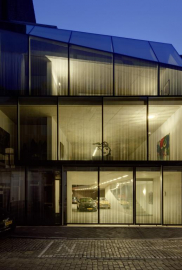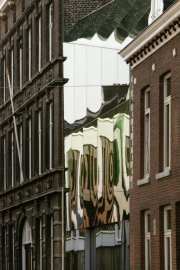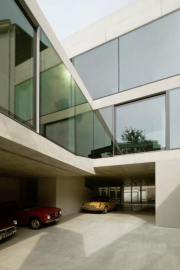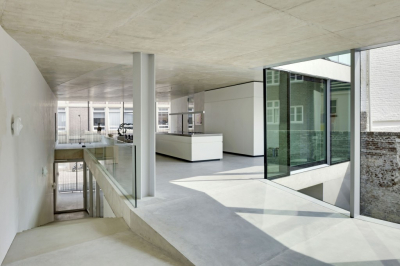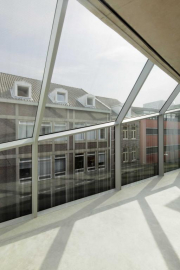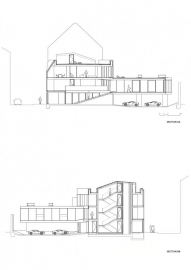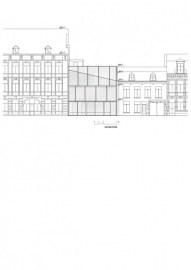V House
V House was constructed for a couple that collects vintage cars, and is stitched within the medieval tapestry of Maastricht. The city dictates all new structures remain within the envelope of pre-existing buildings, and so a cut was created in the houses front façade to generate a triangulated surface, which leads from one neighbors sloped roof to the opposite neighbors vertical bearing wall. As the houses site is long and narrow, voids were cut into the maximum permitted volume to ensure that natural light spills throughout the interior. The ground floor is both open to the exterior elements and sunken to the rear of the site, which makes possible the maximum two-story height allowance. A covered portion of this exterior space serves as an outdoor parking garage for the owners collection of Aston Martins.
As the house finds refuge between two historical buildings, it is a burst of modernity within this currently gentrifying neighborhood of Maastricht. The house is enormous, totaling 530 m2, and is entered through two oversized sliding glass doors that perforate its front façade. These doors serve as the houses main entry and open to either their left or right for entry by foot, and both simultaneously retract to allow the entry of automobiles. Due to safety and privacy concerns, these glass entry doors have no handles or keyholes and are instead are remotely opened from any iPhone, from anywhere in the world. For further privacy the houses front façade was fritted with a gradient pattern of dots, which disperse in placement as the house rises towards the sky and focus at a distance to compose an image of curtains fluttering in the wind. Actual curtains align the interior of the front façade to afford additional privacy.
Circulation throughout the house occurs via two paths. A slow stair leads from the ground floor to the expansive living room, which is connected to the partially raised kitchen and dining areas by a small ramp. A fast stairwell traverses the entire height of the house and, together with the platform elevator, allows for direct vertical shortcuts to all levels of living. Thus this house, with its multiple circulation interventions, such as its living room ramp and fast and slow paths, is organized not around the traditional notion of stacked floors and is instead organized around its circulatory section. At the apex of this fast route is the entrance to an expansive roof terrace thats also the most public space of the house, as it offers panoramic views over the spired roofline of Maastricht.
The living room has been suspended from two I-beams that span two masonry bearing walls that surround the rear of the site. Steel tension rods measuring 5x10 cm extend from these I-beams into the almost fully glazed façade of the living room, which allows its volume to float above the Aston Martins below. For privacy reasons, this glazing was treated with a highly reflective coating that casts a hue of chartreuse or amber depending on the season and angle of the sun. Only when inhabiting the master bedroom is this hanging of the living room apparent, as the I-beams are visible from the master bedroom, which opens onto the living room s roof, which functions as a private terrace for the owners.
Heating and cooling is provided via a concrete core activation system concealed within the floors and ceilings of the house, while all storage is built into the circulatory areas in order to divide spaces and define rooms. The V House an expression of free space in a regulated heritage context.

